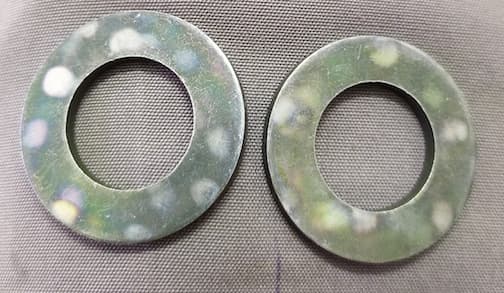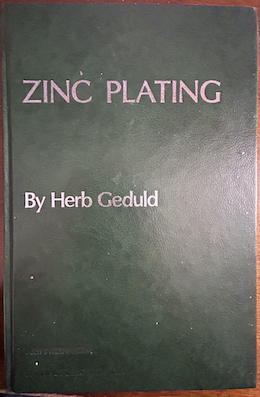
-----
Zinc Plating: clear, yellow, green passivation differences
Q. I have fully automatic acid zinc plating barrel line. When I try to do plating of trivalent passivation of green chrome on zinc finished surface I got white coloured marks. This problem is not faced in yellow and silver passivation.

- LUDHIANA Punjab
March 11, 2021
A. Hi Abhishek. The pattern is distinct enough and regular enough that it's certainly not random. It's probably echoing the barrel holes in some way. Perhaps the zinc plating is different at the holes. Excessive iron manifests itself this way, although in my limited experience it turns black rather than white. Or possibly it's related to the area of the parts against the hole getting more exposure to chromating solution.
I guess I'd suggest plating a Hull Cell ⇦ huh? panel with your acid zinc and then dipping it in the green chromate to see if the defect is related to something that happens at high current density -- perhaps you'll get a white stripe or a white end on your panel. But if you can't do that for some reason, I'd suggest maybe a peroxide treatment to reduce the iron would help.
Luck & Regards,

Ted Mooney, P.E. RET
Striving to live Aloha
finishing.com - Pine Beach, New Jersey
Ted is available for instant help
or longer-term assistance.
March 2021
A. This defect is related to high voltage.
Alireza Barmeh- Isfahan Iran
July 22, 2021
![]() Thanks, Alireza, you're probably right. It's probably 'burning' at the high current area at the barrel holes. A Hull Cell panel may demonstrate it.
Thanks, Alireza, you're probably right. It's probably 'burning' at the high current area at the barrel holes. A Hull Cell panel may demonstrate it.
Luck & Regards,

Ted Mooney, P.E. RET
Striving to live Aloha
finishing.com - Pine Beach, New Jersey
Ted is available for instant help
or longer-term assistance.
July 2021
⇩ Related postings, oldest first ⇩
Q. I want to know about the processing of zinc plating, different types of passivations (clear, yellow, green), what are all the chemicals used, what will be the approximate cost per kg of each chemical, how this is being processed also their advantages and disadvantages.
Muthusamy [surname deleted for privacy by Editor]- Hosur, Tamilnadu, India
2003
![]() Buy a book. You are asking for hundreds of pages of information.
Buy a book. You are asking for hundreds of pages of information.
- Navarre, Florida
2003
A. Hi Muthusamy. In general, the darker the passivation, the greater the corrosion resistance because the heavier the coating. Typically 12, 96, 150 salt spray hours respectively for clear, yellow, olive drab. Many plating shops would not charge more for yellow than clear, despite the somewhat greater chemical usage. Many shops don't have olive drab, so the ones that do probably do charge a bit extra as a "special". These chromates are proprietary chemicals, so you can get pricing from your plating chemical supplier.
But Jim is certainly right that answering all your questions would take hundreds of pages, and that if you don't have a zinc plating book you probably need to start with one. Good luck!

Ted Mooney, P.E.
Striving to live Aloha
finishing.com - Pine Beach, New Jersey
Ted is available for instant help
or longer-term assistance.
2003
Q. Is green passivation possible on nyloc nuts?
Suresh Selvam- hosur, tamilnadu, India
August 1, 2015
A. Hi Suresh. So that the earlier discussion doesn't mislead you: back in 2003 and earlier, chromate conversion coatings were most commonly based on hexavalent chromium compounds, and the corrosion resistance and the depth of color were proportional to the thickness of the chromate film, so olive drab was thicker and more corrosion than yellow, which was thicker and more corrosion resistant than clear/blue. With the need for RoHS compliance came newer technology trivalent chromating, but a muddled proprietary situation of thin film vs. thick film, topcoated vs. non-topcoated, inherent color vs. dyed colors vs. post-dyed colors. Yes, olive drab COLOR RoHS-compatible trivalent chromating is available, but textbook references to its greater thickness and corrosion resistance are not necessarily true anymore. Other shades of green are available as well.
Nylon is not as resistant as many other plastics to the acids and alkalies used in electroplating, but to my knowledge green passivated nyloc nuts should be available. Green passivation is not as common as yellow and clear though.
Regards,

Ted Mooney, P.E. RET
Striving to live Aloha
finishing.com - Pine Beach, New Jersey
Ted is available for instant help
or longer-term assistance.
August 2015
Q, A, or Comment on THIS thread -or- Start a NEW Thread
